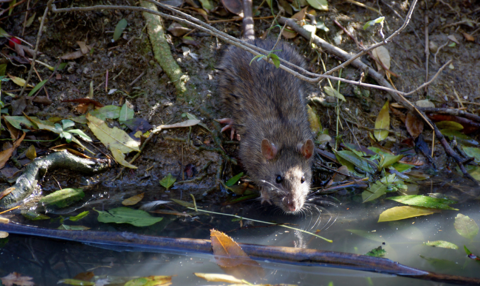The Norway rat, Rattus norvegicus, is one of the most important pest species globally and the main reservoir of leptospires causing human leptospirosis in the urban slums of tropical regions.
Salvador, Brasil is a large city of three million residents that has experienced a 280% increase in its population since 1970. Much of this added population is concentrated in favelas that are characterized by refuse piles, open sewage and overgrown vegetation. These conditions promote Norway rat infestations – a reservoir host for the zoonotic pathogen that causes leptospirosis.

Leptospirosis outbreaks occur each year in favelas and millions of dollars are spent annually on public health campaigns to eradicate these rats. In order to target interventions, epidemiologists and public health officials have requested information on the areas where rats are moving between suitable slum habitats.
We are part of an international team studying leptospirosis in the favelas of Salvador (Brazil) and collaborating with a team of US and international scientist to look at the patterns of genomic differentiation of Norway rats in urban setting to understand the environmental features that shape its population distribution and infer the origin of rats invasions. To do this we are using both microsatellite loci and SNP based surveys ddRADSeq sequencing combined with environmental and epidemiological data The information from this work will then be used to develop empirically based control measures.

Collaborators: A. Ko, J. Child (Yale, EPH), Mary Burak (Yale, Forestry), J. Shirvell, K. Dion (Yale), F. Costa, M.G. Reis (Salvador, Brazil), J. Richardson (Providence College), J. Munshi-South, E. Puckett (Fordham Un.), M.J. Blum (Tulane Un.)
Publications: Puckett, E. E., Park, J., Combs, M., Blum, M. J., Bryant, J. E., Caccone, A., … & Keightley, P. D. (2016). Global population divergence and admixture of the brown rat (Rattus norvegicus). Proceedings of the Royal Society B: Biological Sciences, 283(1841), 20161762.
Costa, F., Richardson, J. L., Dion, K., Mariani, C., Pertile, A. C., Burak, M. K., … & Caccone, A. (2016). Multiple paternity in the Norway rat, Rattus norvegicus, from urban slums in Salvador, Brazil. Journal of Heredity, 107(2), 181-186.
Combs, M., Byers, K. A., Ghersi, B. M., Blum, M. J., Caccone, A., Costa, F., … & Munshi-South, J. (2018). Urban rat races: spatial population genomics of brown rats (Rattus norvegicus) compared across multiple cities. Proceedings of the Royal Society B: Biological Sciences, 285(1880), 20180245.
Kajdacsi, B., Costa, F., Hyseni, C., Porter, F., Brown, J., Rodrigues, G., … & Caccone, A. (2013). Urban population genetics of slum‐dwelling rats (R attus norvegicus) in S alvador, B razil. Molecular ecology, 22(20), 5056-5070.
Richardson, J.L., M.K. Burak, C. Hernandez, J. M. Shirvell, C. Mariani, T. S. A. Carvalho-Pereira, A. C. Pertile, J. A. Panti-May, G. G. Pedra, S. Serrano, J. Taylor, M. Carvalho, G. Rodrigues, F. Costa, J. E. Childs, A. I. Ko, and A. CACCONE. Using fine scale spatial genetics of Norway rats to improve control efforts and reduce leptospirosis risk in urban slum environments.
Evol Appl. 2017 Feb 23;10(4):323-337. doi: 10.1111/eva.12449. eCollection 2017 Apr. PMID:28352293.
Richardson, J.L., G. Silveira, C. Mariani, A. C. Pertile, J. Childs, A. Ko, F. Costa, A Caccone. Rapid population genetic impacts accompany an urban rat control campaign in Salvador, Brazil. Frontier in Ecology and Evolution (in review).


